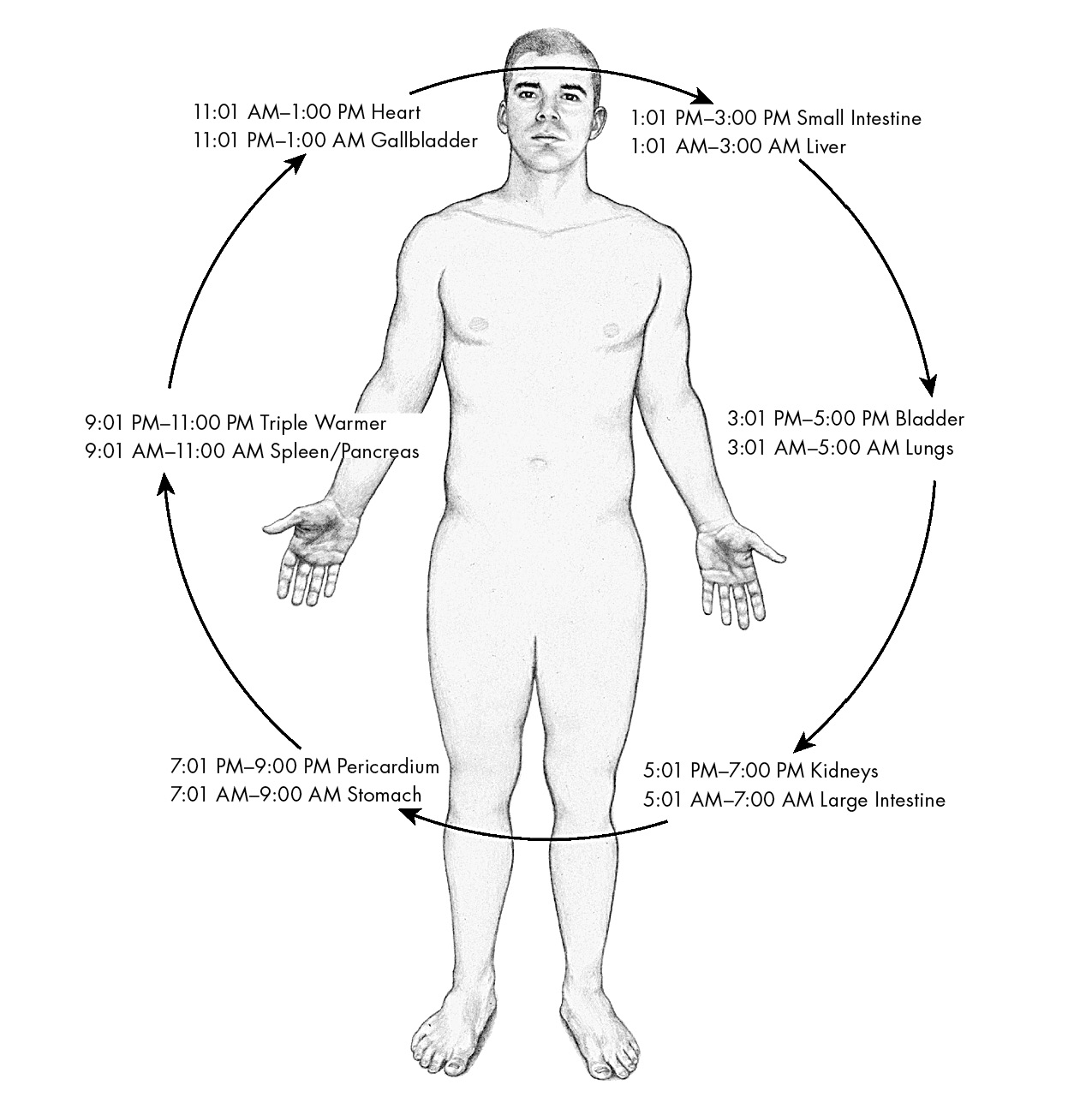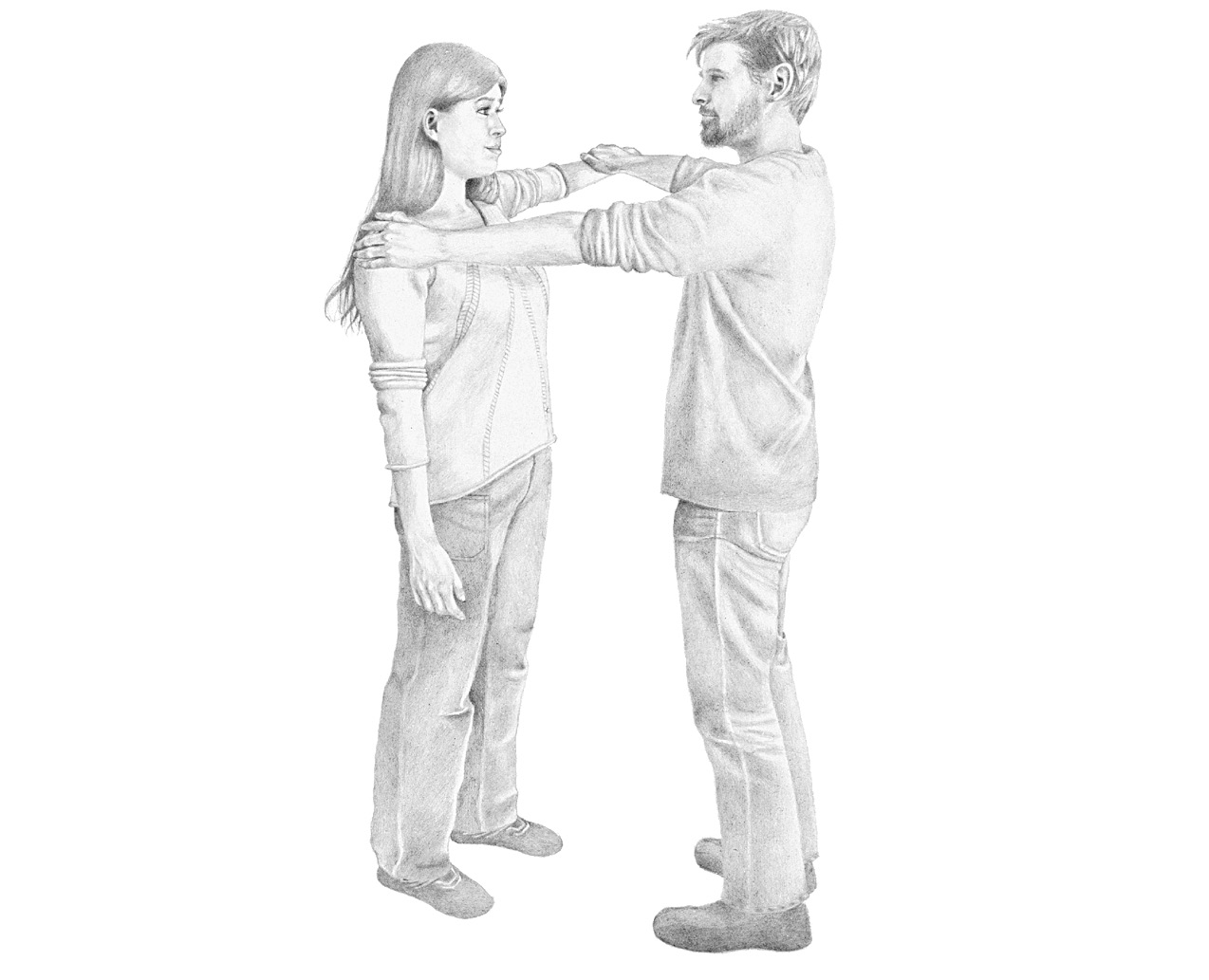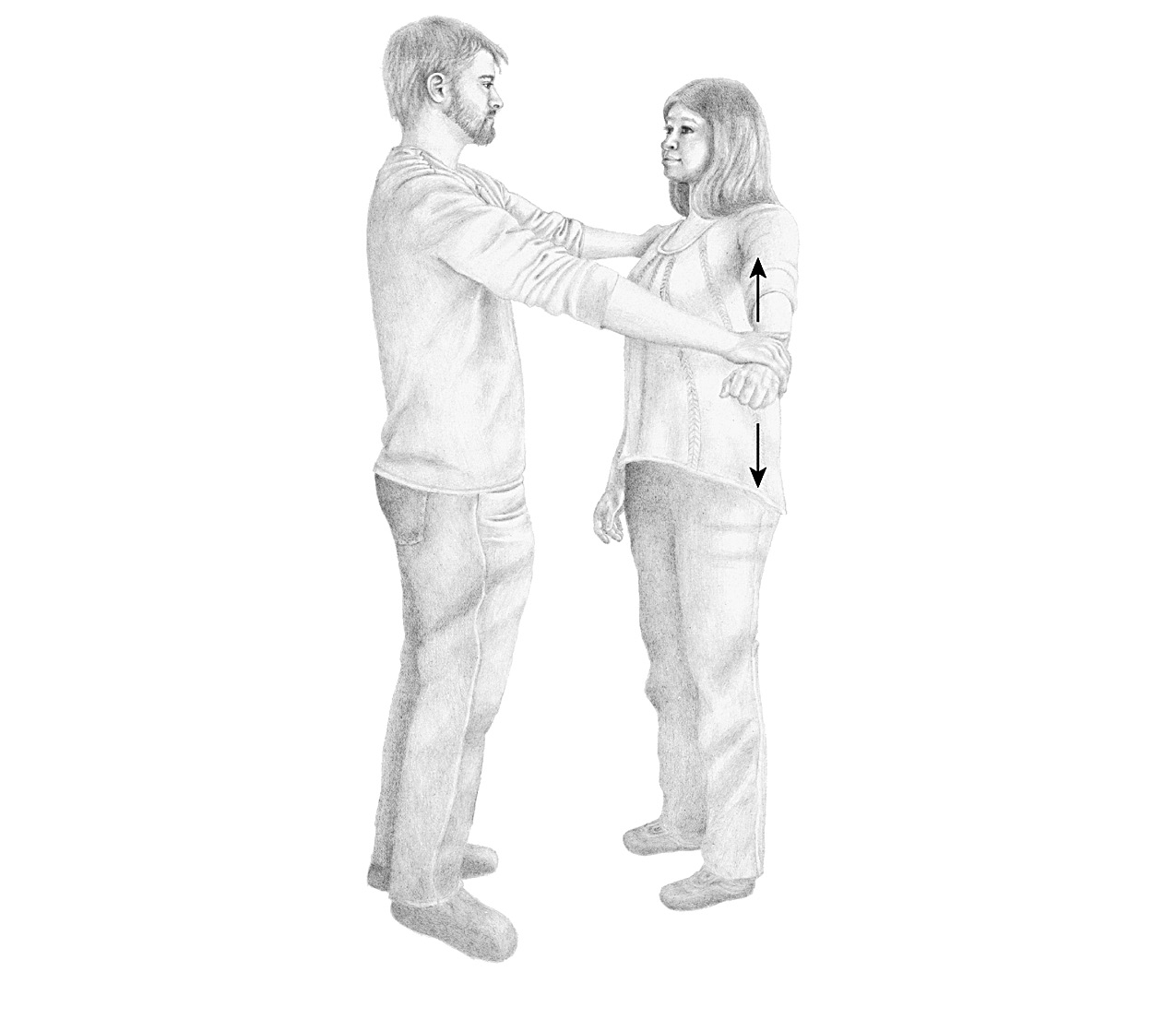Whole Health (13 page)
Authors: Dr. Mark Mincolla

In order to attain wholeness, the energies that flow within and from our vital organ systems demand that ch'i be constantly assessed, balanced, and preserved.
THE CH'I BODY CLOCK
The Ch'i Body Clock assessment is one of the simplest ways to tap into vital organ disharmonies (see Figure 4.2). The ancient Chinese believed that ch'i entered into the organ systems at specific times and that by being aware of the state of our body energy during those times, we could learn a great deal about our organ system
balances and imbalances. For example, if someone is frequently awakened and their sleep disturbed between 1:00 a.m. and 3:00 a.m., it would indicate excess liver ch'i. If someone experiences extreme fatigue each evening between 5:00 p.m. and 7:00 p.m., it would indicate deficient kidney ch'i. It is important to include these body clock assessments as part of a greater global awareness of self. For example, if one is grieving the loss of a loved one, is experiencing labored breathing (lungs), and is awakening frequently between 3:00 a.m. and 5:00 a.m. they would likely be suffering from lung ch'i deficiency. Grief, lung debilitation, and restlessness between 3:00 a.m. and 5:00 a.m. are all lung markers.

FIGURE 4.2
The Ch'i Body Clock
MUSCLE TESTING
Whole Health has developed its own customized system of neuromuscular biofeedback as a vehicle for assessing, balancing, and preserving ch'i. Classical Chinese medicine represents a 5,000-year-old history of human energy diagnostics. I credit those ancient masters as the true originators and progenitors of muscle testing. Applied kinesiology (muscle testing) as we know it today was formally founded by Dr. George Goodheart in the early 1960s. A quick definition of applied kinesiology (AK) is that it is a muscle-testing biofeedback procedure that allows a practitioner quick, easy access to discovering energetic body imbalances between cells, nerves, muscles, and organ systems.
Goodheart discovered that each large muscle in the body energetically correlates to specific major gland and organ systems, which are tied together by nerve cells. This connection (neuromuscular) between nerve and muscle is what makes the muscles so reactive and so revealing of conditions in the body and mind. Goodheart's remarkable muscle testing system incorporated elements of his genius as a chiropractor.
Over the past several decades, many additional contributions have been made to the art and science of muscle testing. Dr. John Diamond developed a system of muscle testing he called behavioral kinesiology. This was also a biofeedback form of muscle testing, but it focused more on the influences the mind has over the body's cells, nerves, muscles, and organs. Where Goodheart's approach was based on the physical, Diamond's was more psychological. In the years that followed, other pioneers, such as Drs. John Thie, David Leaf, John Campbell, Richard Versendaal, and David Hawkins, were among the many that made noteworthy contributions to understanding this great diagnostic tool.
Today there are a number of muscle-testing systems, each with its own unique approaches and theories. This one-of-a-kind healing
art serves as a testament to the great traditions in energy diagnostics, such as classical Chinese medicine. Like classical Chinese medicine, muscle testing has been free to evolve without the restriction of standardization or regulation. For the most part, there have been no oppressive governing bodies or administrative structures set in place to stunt its growth. It's always been about healing masters that have passed down their insights from generation to generation. Each practitioner remains free to add their own unique insights to an ever-evolving, healing art form. Any natural phenomenon such as human neuromuscular biofeedback should serve as a reminder that the ways of nature are not inventedâthey are merely discovered and shared.
WHOLE HEALTH ELECTROMAGNETIC MUSCLE TESTING (EMT)
EMT allows practitioner and subject to diagnostically assess and regulate mutable constitutionality in a dynamic, natural way. Nature has designed our defense system to be one of our most powerful and consistently reliable mechanisms. This is because nature's greatest priority is for the survival of our species. Thus, as was discussed in chapter 3, we've been given sixth-sensory awareness. As such, our protective alarm systems have been designed with an extrasensory hair trigger intended to respond to virtually all perceived stimuli, even if only imagined. As we saw earlier, when you intuitively anticipate a negative outcome or have a bad dream, your heart rate will elevate. Intuitive thoughts and dreams alone are more than enough to set off our defense system's neurological triggers. Our bodies, minds, and spirits remain at the ready to respond to any and all stimuli. Such is the way of our protective sixth-sensory biofeedback. This response is first registered by our nerves and musclesâthe neuromuscular system. To interpret the messages from our neuromuscular biofeedback system, one can simply
try an exercise I introduced you to earlier, where a subject lifts their arm and attempts to resist as a practitioner depresses their arm while presenting a variety of verbal stimuli. Words alone produce images in the mind that are more than capable of activating or deactivating the nerves within our muscles. And, as with the dream example, it doesn't take much to activate our alarm systems. Words alone will trigger a positive or negative biofeedback response. For example, a word like
danger
will generally be more than enough to weaken one's neuromuscular biofeedback response, while the word
happiness
will tend to strengthen it.
There are twelve applications that make up the Whole Health EMT system. These twelve are comprised of four basic, four primary, and two secondary applications, as well as two self-testing techniques. There is also a supplemental longevity application offered at the end of this chapter. In order for students to properly learn this energy system, they must first master each of the twelve applications in proper sequence.
The Four Basic EMT Applications
1.
EMT
Pass/Fail
Position
and
Testing
âBefore you begin testing, the practitioner will need to obtain a sugar packet such as is used to sweeten coffee. Next, the practitioner and subject stand face-to-face at arm's-length distance (see Figure 4.3). Practitioners should employ their dominant hand as their test hand because the dominant hand is more sensitive to energetic subtleties. (But, as the practitioner becomes more experienced, they should alternate hands so as not to become right/left imbalanced.) Next, the practitioner should instruct the subject to raise their left arm (provided the practitioner is right dominant), slightly higher than shoulder height. Then, ask them to clench the fist of their raised (test) hand. Next, instruct the subject to resist as you gently attempt to depress their raised and arm wrist with your dominant hand as you push evenly and lightly on the subject's wrist. Just
spend the next three to five minutes getting accustomed to the strength and resistance tendencies of your subject. Remember, you are partners who are very much reliant on each other for accurate results. So take some time to establish a good energy rapport with each other. Soon you should have a pretty good idea what your subject's test strength baseline feels like. The test strength baseline is the same as a test pass strength. Once test pass strength is determined, it should be easy to distinguish a test fail. With your free hand, hold a sugar packet close to the subject's heart and give their test arm a light tug at the wrist. This is a most assured way to guarantee a fail test result.

FIGURE 4.3
EMT Pass/Fail Position
2.
EMT
Tuning
âTuning will take you to the next level beyond pass/fail. Once again, practitioner and subject must assume pass/fail position. To bring practitioner and subject better in tune with each other, the practitioner should begin by simply
calling out a negative word such as
hopelessness,
while simultaneously administering a pass/fail muscle test. Just from hearing a negative word, the subject will record the energy of the word at a neuromuscular level, prompting a failed muscle test. If need be, practitioners should make several attempts to get a fail response. You might even consider trying other negative words. One negative word may have a more powerful influence on a given subject than another. Clearly, some negative wordâ
hopelessness,
cancer,
or
lonely
âwill produce a natural loss in the subject's arm strength. Now, repeat the exact same tuning procedure, but this time call out a positive word like
vibrant
. Again, repeat it several times, until you establish a strong, resistant, positive arm response. You might try other positive words, such as
happy,
healthy,
or
love
, just to establish clear tuning. Tuning is absolutely essential in order to establish a good testing rapport between practitioner and subject. Remember, EMT is an extrasensory muscle-testing system. The sources of biofeedback information are the practitioner's and subject's intuitions, generated by the cardiac intrinsic ganglia and transmitted to mind, brain, and body.
3.
EMT Pulse Testing
âPulse testing enables the Whole Health practitioner and subject to determine the exact relative score of any given muscle test. With tuning, you were able to discover the sharp contrasts in muscle strength between positive and negative words. With pulse testing, you will determine the exact degree of positive and negative influence virtually any influences (words, foods, vitamins) have on your subject. In order to begin pulse testing, the practitioner and subject must first assume pass/fail positioning. Now let's assume the subject failed a tuning test when hearing the practitioner call out the word
hopeless
. The practitioner must first announce aloud that they are going to test exactly how negatively the word
hopeless
affects the subject's nervous system in relative numbers between minus 1 and minus 10,
with minus 10 representing the most negative effect. Then the practitioner will call out the word
hopeless
once again and instead of just pushing down the subject's arm, this time the practitioner will try pulsing their arm while slowly counting from minus 1 to minus 10 (see Figure 4.4). If their arm drops at minus 1, the word isn't having a severely negative effect. If the subject's test arm remains strong until a count of minus 10, however, it indicates that the word is having an extremely negative effect on their neuromuscular system, etc. The same pulse testing can be performed for positive responses from plus 1 to plus 10 as well. Pulse testing can also be utilized for organ testing, food testing, and focus reliability testing. More about that in a moment.

FIGURE 4.4
Pulse Testing
4.
EMT
Focus/Reliability
âFocus/Reliability is a procedure that technically might best be performed before any other EMT protocols, but by advanced students only! Beginners must first
establish familiarity with pass/fail position testing, tuning, and pulse testing. Focus reliability enables practitioner and subject to ensure that they are both integrally focused, intentionally clear, and energetically accurate. When pulse testing for focus/reliability, the practitioner should first verbally pose the following question to the subject: “What is our present degree of focus/reliability from one to ten, with ten being the highest number?” Then you should attempt to gently pulse test the subject's arm at the wrist with a “one at a time” push approach, while counting out from one to ten as they do. When the subject's arm weakens and drops, you'll have arrived at your focus/reliability factor. Note that nothing less than 10 is acceptable! If the score is lower, simply ask that both of you consciously acknowledge your lack of focus/reliability, and then immediately remedy the problem with a higher commitment and mental focus from both of you. In other words, you must establish accuracy before performing any further testing! I've found that by merely calling attention to the lack of focus/reliability, things usually snap right in place. Once again, the practitioner pushes down on their partner's arm and calls out score numbers from 1 to 10. This is typically all it takes to get the focus/reliability up to 10. Now that you have completed the five preliminary EMT protocols, you are ready to commence with the principal EMT vital organ, organ root reference, and food testing protocols.